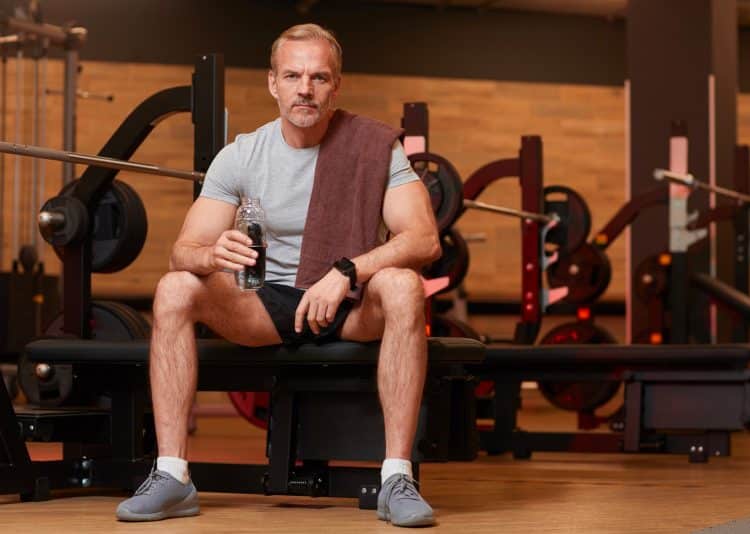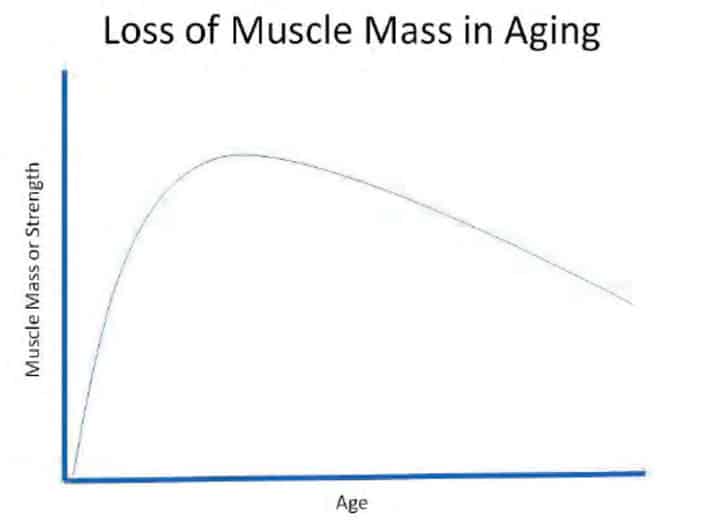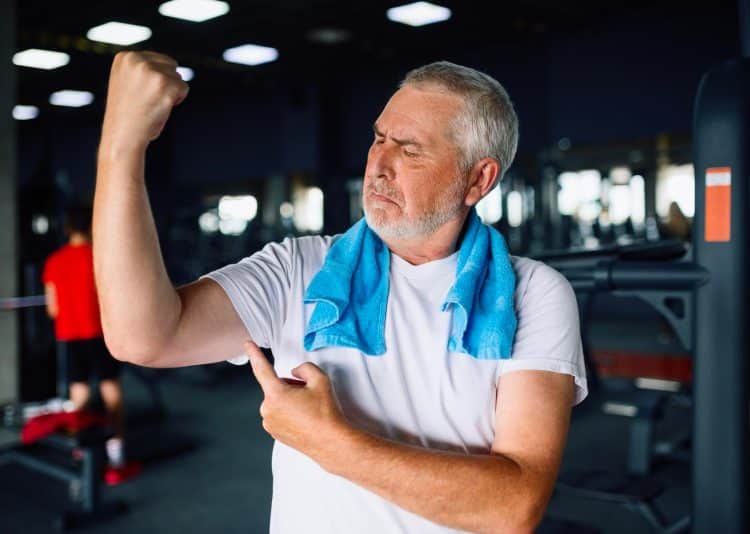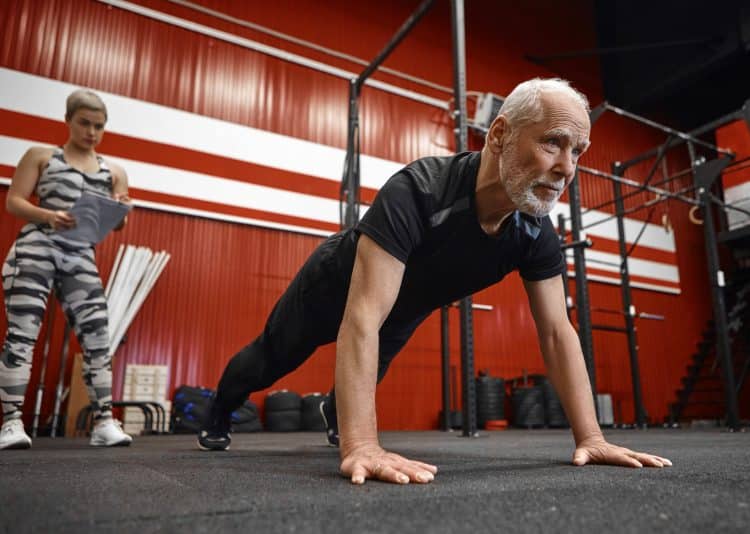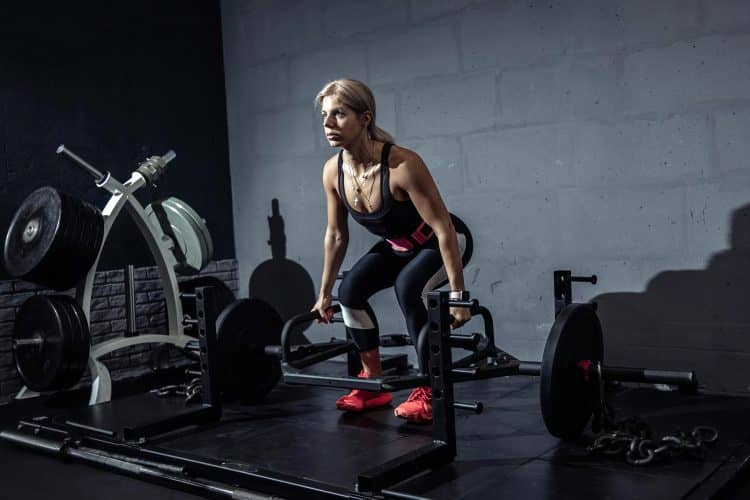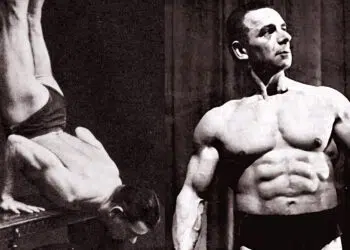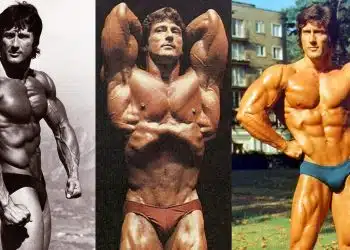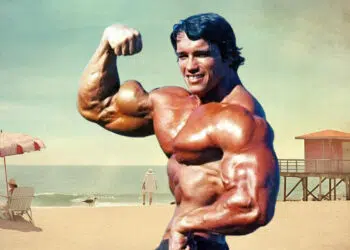Strength training, bodybuilding, and powerlifting are often seen as activities best suited to people in their 20s and 30s. And, let’s be frank, things like the size of your biceps, rock-hard abs, or your bench press one rep-max are a much bigger deal when you’re young.
Folks in their 50s are usually less interested in athletic performance or looking like a Greek god or goddess. Instead, they’re more focused on warding off middle-aged weight gain, managing their blood pressure and cholesterol, or avoiding the aches and pains that come with getting older.
However, not only is strength training still important as you age, it could actually help you live longer.
Forget about lifting weights to look good, although that’s still a benefit even with you’re in your 50s. Building muscle improves many aspects of your health and fitness, including pushing back the day of your funeral!
In this article, we reveal some of the biggest benefits of building muscle in your 50s, how to do it, and a program to follow. We’ll also answer your most common after-50 strength training questions.
The Benefits of Building Muscle After 50
Level Up Your Fitness: Join our 💪 strong community in Fitness Volt Newsletter. Get daily inspiration, expert-backed workouts, nutrition tips, the latest in strength sports, and the support you need to reach your goals. Subscribe for free!
Humans are, by nature, lazy. This is no bad thing because it’s this laziness and inherent drive to preserve energy that has led to most of the technological advancements and luxuries that we now take for granted.
We use mechanized transport instead of walking, mains water instead of drawing water from wells, electric lights instead of fire, and supermarkets instead of hunting and gathering. Life is, by and large, pretty easy.
However, that laziness means that many people are sedentary and struggle to find the motivation to exercise regularly. Because of this, it is critical to understand the benefits of working out.
Knowing the benefits will give you a greater reason to participate and stick to your workout routine. You’ll know WHY you are doing it, which can be a powerful motivator. The next time you are thinking of skipping a workout, just remind yourself of all the benefits you’ll be missing out on:
Muscle and strength preservation
Muscle mass naturally peaks in your mid-30s and declines by between 3-8% per decade after that. This muscle loss is called sarcopenia and helps explain why older people are usually far weaker than their younger counterparts. Age-related muscle loss can have a significant impact on many aspects of your life, from your ability to walk to your balance to being able to get out of bed to longevity (1). Muscle loss is also closely linked to poorer mental and physical health.
The good news is that regular strength training can slow this rate of muscle loss to a crawl, and you can also regain lost muscle at almost any age. Sure, building muscle is more challenging in your 50s than in your 20s and 30s, but you can still do it.
Easier weight management
As muscle mass tends to decline with age, fat mass increases (2). This is often called middle-aged spread, referring to the gradual expansion of the waistline. Losing muscle decreases your metabolic rate, and being less physically active means you are more likely to have a calorie surplus. All these factors contribute to weight gain.
Building muscle can help make it easier to maintain your weight or lose fat. Muscle is metabolically active tissue and uses more calories than fat. Preserving your muscle mass can help prevent the metabolic slowdown generally associated with advancing age.
Increased bone mass
Like your muscles, bone mass also decreases with age. This is called osteopenia, which, if ignored, can become osteoporosis, a medical condition characterized by weak, porous, fracture-prone bones.
When you strength train, your muscle pull on your tendons which, in turn, pull on your bones and the tissue surrounding them, called the periosteum. This stimulates the osteoblast cells, which are responsible for bone growth.
As your muscles get stronger, so too do your bones. Stronger bones are less prone to fractures. Broken hips are a leading cause of disability in older people (3).
Blood glucose management
While it’s normal for your blood glucose levels to rise and fall, chronically elevated blood glucose can have a significant impact on your long-term health. If unchecked, chronically high blood glucose can lead to:
- Diabetes
- Obesity
- Kidney disease
- Heart disease
- Circulatory problems
- Impaired immunity
- Nerve damage
- Blindness
Strength training improves your body’s ability to utilize glucose. After training, blood glucose is diverted to your muscles and liver, where it’s stored as glycogen (4).
Lifting weights also improves your insulin sensitivity, which is the hormone responsible for controlling your blood glucose. Better insulin sensitivity means your body can metabolize sugar and carbohydrates more easily.
Combined with a healthy, low-sugar diet, lifting weights can help manage or even prevent chronically elevated blood glucose.
More stable, mobile joints
Joint pain often goes hand-in-hand with getting older. Your knees, hips, and shoulders have seen a lot of use over the last five or more decades and will probably show some signs of wear and tear. Joint pain can be enough to put some people off working out.
However, building muscle can help reduce joint pain or prevent it from worsening. Stronger muscles help stabilize your joints, preventing unwanted movement and taking stress away from the bones. In addition, the stronger you are, the less challenging things like walking, lifting, and carrying become, which also helps reduce joint stress.
Many strength training exercises are also good for your mobility – the health and range of motion of your joints. They can also help reduce joint pain (5). Squats, lunges, pulldowns, and push-ups all enhance mobility as they build strength.
While you may need to adapt your workout according to your joint health, avoiding exercises you find uncomfortable, building muscle should have a very positive impact on how your joints feel and function. Joints typically weaken and stiffen from lack of use, and not because of exercise. If you want your joints to stay healthy, you need to use them.
Improved neurological function
If your muscles and bones are your body’s hardware, your nervous system is its software. Lifting weights has a powerful effect on your nervous system and will improve how it functions. The neurological benefits of strength training include better balance, improved coordination, and greater proprioception (7).
Improved neurological function will help you move better, making the day’s activities easier. You’ll also be less prone to falls, which are a serious cause for concern in older adults.
Better mental health
Leading on from the point above, building muscle isn’t just good for your muscles and bones but for the old brain box too! Regular strength training can have a profound effect on many aspects of mental health, including:
- Better memory
- Improved creativity
- Increased problem-solving ability
- Lower risk of depression
- Reduced anxiety and stress
- More positive outlook
- Lower risk of dementia, Alzheimer’s disease, etc.
Mental and physical health are closely related, and building muscle has a positive impact on both.
Better posture
Posture is the alignment of your joints. When you are in good posture, there is very little stress on your bones and muscles. However, poor posture is much harder on your muscles and joints and can even affect blood flow to your brain.
Regardless of age, lifting weights is one of the best ways to strengthen the muscles you use to maintain good posture. Exercises for the posterior chain (glutes, hamstrings, lower back), core, and upper back are crucial for fixing slouches and rounded shoulders.
Posture can deteriorate with age, which results in changes in your center of gravity and balance (6), leading to an increased risk of falling. You’ll look and feel younger and move better if your posture is good.
Improved cardiovascular fitness and health
If you want a stronger heart and healthier lungs, you must do cardio, right? While cardio is good for cardiovascular fitness and health, strength training is also beneficial. Lifting weights involves short periods of work followed by brief rests. This is basically interval training, which is a popular form of cardio.
Compound exercises like squats, bench presses, and bent-over rows engage multiple muscles, which, in turn, demand a lot of oxygen. This leads to an increase in heart and breathing rate despite not being a typical cardio workout.
While cardio training is rarely a bad idea, it’s reassuring to know that strength training is also good for your heart and lungs.
As you can see, building muscle is “big medicine,” even after your 50s. Use these benefits to motivate you to exercise regularly and consistently. Your efforts will pay off!
However, older exercisers should still check in with their primary physician before starting a new workout plan. This information is not meant to replace your doctor’s advice.
Guidelines for Building Muscle After 50
Now you know WHY you need to build muscle after 50, let’s move on to HOW to do it. Follow these guidelines to ensure you get the most benefits from the least amount of time and effort while making your workouts as safe as possible.
Build your workouts around compound exercises
Exercises come in two main “flavors,” compound and isolation. Compound exercises involve multiple muscles and joints working together, providing the biggest bang for your workout buck. Compound exercises also tend to be more functional, i.e., they mirror the demands of everyday life.
In contrast, isolation exercises are typically less functional and less efficient. You need to do a lot of isolation exercises to train your entire body compared to just 3-5 compound lifts.
That doesn’t mean isolation exercises are bad, but for the most productive workouts possible, most of your workout time should be spent on compound exercises.
Read more about the differences between compound and isolation exercises here.
Choose exercises you enjoy and tolerate well
Fitness experts love to argue about the best way to build muscle and strength. It gives us something to talk about over our post-training protein shakes! However, enjoyment and tolerance are the real determinants of what makes a good exercise, at least for those in their 50s.
Enjoyable exercises leave you wanting to come back for more and not dreading your next workout. However, those exercises should also suit your body and not cause unnecessary discomfort and pain.
So, if you hate bench presses because they hurt your shoulders, do something else instead. Even if it isn’t the so-called “best” exercise, sticking to what you enjoy and can tolerate means you are more likely to work out consistently, and that’s what really matters.
Do at least ten sets per muscle group per week
While you don’t need to do a lot of long workouts to build muscle in your 50s, you need to do enough to produce the desired results. According to science, that means doing at least ten sets per muscle group per week but less than 20 (9).
You can spread these sets across several workouts using a split routine where you train different muscles on different days or, more efficiently, using full-body workouts.
Doing at least ten sets per muscle per week will ensure you get the desired results. And while you can do more, there is a point of diminishing returns, and subsequent improvements will be less significant. More work will also be harder to recover from, which could affect workout intensity or frequency.
Lift weights 2-4 times a week
You don’t have to go to the gym every day to build muscle in your 50s. In fact, 2-4 workouts per week work best for most people. This provides a good balance between working out and time for rest.
As you hit your 50s and beyond, your body takes longer to recover from bouts of intense exercise, and training before you are recovered could harm your progress. In many cases, working out less and not more often is the best approach.
So, there is no need to become a gym addict in your quest to build muscle. Anywhere from 2-4 workouts per week will get the job done.
Level Up Your Fitness: Join our 💪 strong community in Fitness Volt Newsletter. Get daily inspiration, expert-backed workouts, nutrition tips, the latest in strength sports, and the support you need to reach your goals. Subscribe for free!
Train with lighter weights for higher reps
According to bodybuilding lore, building muscle involves lifting moderate to heavy weights for 6-12 reps per set. While undeniably effective, this type of training can be hard on your joints and may not be appropriate when you’re in your 50s.
However, research suggests you can build muscle with light weights and high reps, provided you take your sets to within a couple of reps of failure (10). So, instead of hoisting 50-pound dumbbells, you can use the 20-pounders and get similar results.
This is also good news if you have high blood pressure, osteoarthritis, or any other condition that may preclude you from lifting heavy weights.
Warm up like a pro
Like a classic car, your mature muscles and joints need extra care to avoid breaking down. This means warming up is critical if you want to prevent injuries. You don’t need to spend all day on your warm-up, but you should dedicate 10-20 minutes to getting your body ready to train.
A general warm-up consists of some light cardio followed by dynamic mobility and flexibility exercises for the muscles and joints you’re about to use. Depending on how you feel and your injury history, you may also need some dedicated foam rolling or movement prep exercises to work out the kinks. Time spent warming up is seldom wasted.
You can read more about warming up for strength training here.
Prioritize mobility and flexibility
In addition to losing strength as you age, older muscles and joints tend to be stiffer and less mobile. This can make some exercises hard or even impossible and affect how you move. The more sedentary you are, the more likely you are to be stiff and immobile.
However, like muscle mass and strength, you can win back lost flexibility and mobility at almost any age. You’ll look and feel younger if you are supple and move with ease instead of creaking about from place to place!
So, prioritize mobility and flexibility. Don’t just stretch on the days you work out. Instead, stretch every day to keep your muscles and joints flexible and mobile.
Check out our stretching archives for more information.
Consistency is king
Sadly, you cannot store fitness. While a couple of missed workouts won’t hurt, more than two weeks off training will cause noticeable decreases in strength and muscle mass. Staying away from the gym for several months could mean losing all your hard-won gains entirely.
As such, consistency is the byword for successful muscle building after 50. You need to keep showing up, and only illness and injury should keep you from your workout plan.
The good news is that even a couple of short workouts per week can preserve your existing muscle mass, so doing something will always be better than nothing.
Look for ways to make your workouts as consistent as possible. You’ll find a host of handy tips here.
Respect your body’s need for rest and recovery
Do you remember when you could party all night and work all day without missing a beat? Well, those days are gone! Now you are older, your body needs more time for rest and recovery, and you need to accept that your progress depends on more than just your workouts.
Make sure you get a good 7-9 hours of sleep per night, and also take days off from exercise to give your body the extra time it needs to recuperate. You are not being lazy; you’re merely respecting your body’s increased need for rest.
Pump up the protein

Building muscle requires a slight caloric surplus and a diet rich in nutrients. However, arguably the most important thing you need is adequate protein.
Protein foods like eggs, chicken, fish, legumes, soy, nuts, etc., contain amino acids, which are the building blocks of life. Amino acids are constantly being broken down and used in your body. Ideally, your intake should exceed what’s being used, putting you into a positive protein balance. However, consuming too little protein means that breakdown will exceed rebuilding, which will limit muscle gain, and could even hasten muscle loss.
Make sure you consume adequate protein so your body always has enough of the materials it needs to repair and build muscle. This usually means about one gram per pound of body weight, but you can get a more accurate protein intake recommendation here.
Don’t just lift weights
As essential as strength training and muscle-building are, they’re only part of the total fitness and longevity equation. If you want to live a long, strong, healthy life, you should balance your strength workouts with cardio and activities that enhance brain health. Vegging out in front of the TV all night will probably NOT extend your life.
Examples of other complementary activities include:
- Walking and hiking
- Swimming
- Cycling
- Traveling
- Learning new skills, e.g., a language or musical instrument
- Artistic or creative activities
- Reading
- Journaling
- Socializing
Most stimulating activities will help ward off the aging process. What you do doesn’t even have to be hard – it just needs to engage your body and brain.
Accept your limitations
While building muscle and strength training are something of a fountain of youth, they can’t hold back the aging process indefinitely, and some decline is unavoidable. Your body changes as it gets older, and so too do your physical abilities. Trying to train as you did in your 20s and 30s is a recipe for injury and heartache. So, shift your sights and accept that you may be unable to do everything you want. Take it from one who knows; this can be a bitter pill to swallow, but there are plenty of things you can still do, including building muscle.
Focus less on what you used to do and more on what you can and want to do in the future.
Start slow, build momentum, and then keep going
If you are new to exercise, the last thing you should do is dive head-first into an intense workout program. Doing too much too soon is a great way to end up sore, injured, and frustrated.
So, start with a program you can complete relatively easily, and gradually increase the workload as your body gets used to exercising regularly. Build up over several months to drive your fitness and strength forward and upward. Getting in shape is a marathon and not a sprint.
Try to make your workouts as automatic as possible. In other words, make them fit your lifestyle so you don’t have to think too hard to do them. For example, exercise immediately after work on the way home to save you from having to go back out. Make this your routine 3-4 days a week. Or, set up a home gym and do your workout on rising.
As we said before, consistency is king, and you’ll get much better results if you create a workout plan you can stick to. Not for a week or a month, but for many years to come.
Building Muscle After 50 Workout
You now have all the information you need to write your own after 50 muscle-building workout. However, to save you the time and effort, we’ve designed one for you.
This is a full-body program you can do 2-3 times per week on non-consecutive days, e.g., Monday, Wednesday, and Friday. This will allow you to accumulate the recommended ten+ sets per muscle group per week.
The exercises are 50+ friendly and should build muscle and enhance function without compromising your joints.
Do this work out for the next 2-3 months and then progress to a more challenging plan when you feel you are able – such as this one. As mentioned above, make sure you precede your workouts with a thorough warm-up.
| # | Exercise | Sets | Reps | Recovery |
| 1 | Reverse lunges | 2-3 | 12-20 per leg | 60-90 seconds |
| 2 | Incline dumbbell bench press | 3-4 | 12-20 | 60-90 seconds |
| 3 | Lat pulldowns | 3-4 | 12-20 | 60-90 seconds |
| 4 | Single-leg Romanian deadlifts | 2-3 | 12-20 per leg | 60-90 seconds |
| 5 | Dumbbell shoulder press | 3-4 | 12-20 | 60-90 seconds |
| 6 | Seated cable rows | 3-4 | 12-20 | 60-90 seconds |
| 7 | Goblet squat | 2-3 | 12-20 | 60-90 seconds |
| 8 | Plank | 3-4 | 20-40 seconds | 60-90 seconds |
| 9 | Paloff press | 3-4 | 12-20 per side | 60-90 seconds |
| 10 | 45-degree back extensions | 3-4 | 12-20 | 60-90 seconds |
Building Muscle After 50 – FAQs
Do you have a question about building muscle after 50? No problem, because we’ve got the answers!
1. How much muscle can you build after 50?
How much muscle you can build after 50 depends on several variables, including your current level of muscularity, body type, training history, diet, motivation, and dedication. For example, novices who are a long way from their genetic potential will probably build more new muscle than a more experienced lifter who is already quite muscular.
So, rather than trying to predict how much muscle you can build after 50, focus more on actually doing it. That’s the only way to discover the answer to this question.
2. What is the best diet for people in their 50s?
Ultimately, the best diet for building muscle AND being healthy in your 50s is the one that provides your body with all the nutrients and calories you need, is based on clean or natural foods, and that you enjoy. This means there are lots of different eating plans you can choose from.
However, many experts believe the heart-friendly Mediterranean diet is one of the healthiest. It’s often linked to a long, disease-free life.
3. Can I change any of the exercises in the after-50 muscle-building workout?
While we have carefully chosen the exercises in the after-50 muscle-building workout, you are free to change them if necessary. For example, you could do single-arm dumbbell rows instead of cable rows or push-ups instead of dumbbell bench presses.
However, if you do make changes, ensure that you use similar exercises to keep the program balanced.
4. Can I do the after-50 muscle-building workout every day?
The after-50 muscle-building workout is a full-body plan meaning it trains all your major muscle groups in a single session. Doing it every day would not give you enough recovery time between workouts.
It’s generally accepted that a muscle group takes 48-72 hours to recover from training, so an every-other-day approach is best. If you want to work out every day, you should do cardio on the days between strength workouts or adopt a different training split.
However, older exercisers usually benefit from at least a couple of complete rest days per week, as the recovery rate may be slower.
5. What weights should I use in the after-50 muscle-building workout?
Unfortunately, only you can answer this question. You’ll need to experiment to find a weight that takes your muscles close to failure within 12-20 reps. If you can’t do 12 reps, the load is too heavy, but it’s too light if you can do more than 20. Pick a weight that keeps you in the 12 to 20-rep sweet spot.
However, don’t panic if you occasionally fall outside of this range. Providing you reach failure, it’ll still be productive. It’s just that 12-20 provides a nice balance between weight and time efficiency.
6. Are there any supplements that will help me build muscle in my 50s?
Contrary to what some nutrition companies want you to believe, you can build muscle without supplements. Provided you train hard and eat right, your muscles will grow. Supplements are a relatively recent invention, yet people have gained muscle for thousands of years!
That said, there are a few substances that may help you gain muscle more quickly, either by providing your body with more of what it needs to grow, increasing workout intensity and/or duration, or accelerating recovery.
Useful supplements include:
- Protein powder
- Creatine
- Pre-workout and caffeine
- ZMA
- Melatonin (natural sleep enhancer)
- BCAAs and EAAs
7. Can I keep lifting weights in my 60s and beyond?
You can and should continue lifting weights for as many years as possible. Your body operates on a system of “use it or lose it,” and if you stop training, your muscles will gradually weaken and shrink. After a few months, you’ll be right back where you started.
The only way to maintain your existing muscle mass, or at least reduce the rate of muscle loss, is to keep on hitting the gym like your life depends on it.
However, your workouts will undoubtedly change as you enter your 60s, 70s, and beyond, but that doesn’t mean you should stop challenging your muscles and working hard.
You don’t stop exercising because you get old; you get old because you stop exercising!
Building Muscle After 50 – Closing Thoughts
You can build muscle at any age – even your 50s and beyond. Yes, it IS harder, as the bodily processes that build muscle start to slow after your mid-30s. But with time, effort, and dedication, you can keep getting stronger and more muscular long past middle age.
In fact, many lifters continue performing incredible feats of strength despite their advancing years, such as Mark Felix, Nick Best, and Odd Haugen. And there are plenty of veteran bodybuilders who still pack plenty of muscle mass, despite being in their 50s and beyond, including Tom Platz, Dorian Yates, and Arnold Schwarzenegger.
While you may never recapture the strength and muscularity of your youth, you don’t have to be weak and skinny, either. Use the information in this article to keep making gains regardless of your age.
References:
- Chang SF, Lin PL. Systematic Literature Review and Meta-Analysis of the Association of Sarcopenia With Mortality. Worldviews Evid Based Nurs. 2016 Apr;13(2):153-62. doi: 10.1111/wvn.12147. Epub 2016 Feb 4. PMID: 26844538.
- Hiol AN, von Hurst PR, Conlon CA, Mugridge O, Beck KL. Body composition associations with muscle strength in older adults living in Auckland, New Zealand. PLoS One. 2021 May 28;16(5):e0250439. doi: 10.1371/journal.pone.0250439. PMID: 34048458; PMCID: PMC8162602.
- Massini DA, Nedog FH, de Oliveira TP, Almeida TAF, Santana CAA, Neiva CM, Macedo AG, Castro EA, Espada MC, Santos FJ, Pessôa Filho DM. The Effect of Resistance Training on Bone Mineral Density in Older Adults: A Systematic Review and Meta-Analysis. Healthcare (Basel). 2022 Jun 17;10(6):1129. doi: 10.3390/healthcare10061129. PMID: 35742181; PMCID: PMC9222380.
- Jiahao L, Jiajin L, Yifan L. Effects of resistance training on insulin sensitivity in the elderly: A meta-analysis of randomized controlled trials. J Exerc Sci Fit. 2021 Oct;19(4):241-251. doi: 10.1016/j.jesf.2021.08.002. Epub 2021 Aug 19. PMID: 34552636; PMCID: PMC8429971.
- Latham N, Liu CJ. Strength training in older adults: the benefits for osteoarthritis. Clin Geriatr Med. 2010 Aug;26(3):445-59. doi: 10.1016/j.cger.2010.03.006. PMID: 20699165; PMCID: PMC3606891.
- Mayer F, Scharhag-Rosenberger F, Carlsohn A, Cassel M, Müller S, Scharhag J. The intensity and effects of strength training in the elderly. Dtsch Arztebl Int. 2011 May;108(21):359-64. doi: 10.3238/arztebl.2011.0359. Epub 2011 May 27. PMID: 21691559; PMCID: PMC3117172.
- Lee IH, Park SY. Balance improvement by strength training for the elderly. J Phys Ther Sci. 2013 Dec;25(12):1591-3. doi: 10.1589/jpts.25.1591. Epub 2014 Jan 8. PMID: 24409027; PMCID: PMC3885846.
- Li Z, Peng X, Xiang W, Han J, Li K. The effect of resistance training on cognitive function in the older adults: a systematic review of randomized clinical trials. Aging Clin Exp Res. 2018 Nov;30(11):1259-1273. doi: 10.1007/s40520-018-0998-6. Epub 2018 Jul 13. PMID: 30006762.
- Baz-Valle E, Fontes-Villalba M, Santos-Concejero J. Total Number of Sets as a Training Volume Quantification Method for Muscle Hypertrophy: A Systematic Review. J Strength Cond Res. 2021 Mar 1;35(3):870-878. doi: 10.1519/JSC.0000000000002776. PMID: 30063555.
- Lasevicius T, Ugrinowitsch C, Schoenfeld BJ, Roschel H, Tavares LD, De Souza EO, Laurentino G, Tricoli V. Effects of different intensities of resistance training with equated volume load on muscle strength and hypertrophy. Eur J Sport Sci. 2018 Jul;18(6):772-780. doi: 10.1080/17461391.2018.1450898. Epub 2018 Mar 22. PMID: 29564973.

